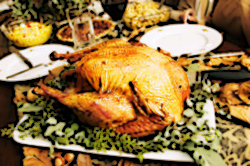 This year as I make plans for Thanksgiving dinner and prepare for my upcoming trip to Salt Lake City, I have a tendency to merge the two events into a question about how my ancestors who were American colonists in the middle of the 18th century actually got it all together. Inevitably it is mass confusion at my house as I prepare the turkey and all the trimmings, hoping I won’t have to keep the dressing warm while the turkey and casseroles finish cooking. No matter how hard I try, something needs a little longer in the oven. Or else the rolls won’t rise. My family looks forward to homemade rolls every holiday and I have never disappointed them; although we have had to wait for the rolls on several occasions.
This year as I make plans for Thanksgiving dinner and prepare for my upcoming trip to Salt Lake City, I have a tendency to merge the two events into a question about how my ancestors who were American colonists in the middle of the 18th century actually got it all together. Inevitably it is mass confusion at my house as I prepare the turkey and all the trimmings, hoping I won’t have to keep the dressing warm while the turkey and casseroles finish cooking. No matter how hard I try, something needs a little longer in the oven. Or else the rolls won’t rise. My family looks forward to homemade rolls every holiday and I have never disappointed them; although we have had to wait for the rolls on several occasions.
My kitchen is an adequate size with many timesaving gadgets. What if I had to bring the wood in from outside, haul water from a well, in addition to growing and preparing all the food? What if there were no grocery stores? The worst scenario I can imagine would be to milk a cow!
Yet our foremothers were adept at preparing meals for several reasons. For starters, families were much larger than the average family is today. These large families included several daughters, daughters-in-law, and even mothers-in-law. Every female had a task to perform and probably did it exceptionally well. Large meals were a daily affair; the wife and daughters were accustomed to such tasks.
Many of my ancestral families lived in the backwoods. I come from lines that not only never lived in towns, and especially cities, but also probably never saw a place as large as Greenville. For the most part they were subsistent farmers who produced everything the family needed. And except for the Civil War period, few went hungry.
My husband and I come from families where women knew how to cook, often without a cookbook or the Internet. Our grandmothers really never had recipes for foods frequently prepared. What I wouldn’t give to know how my mother made Chicken and Dumplings or my Grandmother made Sugar Cookies; or my mother-in-law makes pecan pies, to say nothing of the wonderful things her mother cooked.
One time I interviewed a great-aunt about life on a Texas cattle ranch in the 1890s through 1915. Thanksgiving was not celebrated. Yet, a search of Thanksgiving on the Internet reveals that George Washington proclaimed the first national holiday on 26 November 1789. In 1863 President Abraham Lincoln set the current tradition of Thanksgiving holidays for those states that remained in the Union. Maybe that is why most of my families didn’t celebrate until 1941 when the fourth Thursday in November was actually set aside by President Franklin D. Roosevelt. Of course, there is always the debate about the date in years with five Thursdays in November like 2012.
I must tell you that I have a miniature orange tree that produced a bumper crop of small oranges this year. This month I prepared twenty small jars of orange marmalade. Maybe I could handle an early American Thanksgiving over a wood stove or fireplace. But milking a cow is definitely out of the question. Thank goodness my husband knows how, though.
